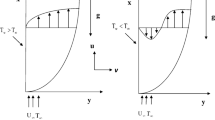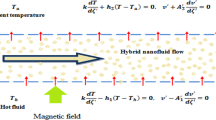Abstract
The current research paper investigates semi numerical study of steady incompressible viscous two-dimension, boundary layer flow for hybrid nanofluids with the influence of viscous dissipation and dynamic viscosity. The three types of nanoparticles (\(Ti{O}_{2},{\hspace{0.17em}}Ag{\hspace{0.17em}},{\hspace{0.17em}}GO\)) are considered, and engine oil is taken as a base fluid. To convert a collection of PDEs to nonlinear ODEs, we applied appropriate transformations. The authors used the Homotopy analysis approach (HAM) to solve this set of equations. The influence of different parameters on temperature, and velocity is intended, and the results are planned with the help of graphs, involving the magnetic field, nanoparticle volume concentration, dynamic viscosity, Eckert’s number, and Prandtl’s number. From the current analysis, we see that the magnetic field, nanoparticle volume concentration, and dynamic viscosity are inversely related to the velocity field; similarly, the Prandtl number is inversely related to the temperature field, and the Eckert number is directly related to the temperature profile. A physical description is used to simulate and evaluate the structures of flow features such as temperature and velocity profiles in response to changes in develo** factors.












Similar content being viewed by others
Data availability
The database used and analysed during the current study are available from the corresponding author on reasonable request.
References
Merkin, J. H. (1969). The effect of buoyancy forces on the boundary-layer flow over a semi-infinite vertical flat plate in a uniform free stream. Journal of Fluid Mechanics, 35(3), 439–450.
Wilks, G. (1973). Combined forced and free convection flow on vertical surfaces. International Journal of Heat and Mass Transfer, 16(10), 1958–1962.
Chen, T. S., & Mucoglu, A. (1975). Buoyancy effects on forced convection along a vertical cylinder. ASME Journal of Heat Transfer, 97, 198–203.
Hunt, R., & Wilks, G. (1980). On the behaviour of the laminar boundary-layer equations of mixed convection near a point of zero skin friction. Journal of Fluid Mechanics, 101(2), 377–391.
Wilks, G., & Bramley, J. S. (1981). Dual solutions in mixed convection. Proceedings of the Royal Society of Edinburgh, 87A, 349–358.
Merkin, J. H. (1985). On dual solutions occurring in mixed convection in a porous medium. Journal of Engineering Mathematics, 20, 171–179.
Ishak, A., & Azar, R. N. (2007). Dual solutions in mixed convection boundary-layer flow with suction or injection. IMA Journal of Applied Mathematics, 72, 451–463.
Mahmood, T., & Merkin, J. H. (1988). Similarity solutions in axisymmetric mixed-convection boundary-layer flow. Journal of Engineering Mathematics, 22, 73–92.
Suresh, S., Venkitaraj, K. P., Selvakumar, P., & Chandrasekar, M. (2012). Effect of Al2O3–Cu/water hybrid nanofluid in heat transfer. Experimental Thermal and Fluid Science, 38, 54–60.
Suresh, S., Venkitaraj, K. P., Hameed, M. S., & Sarangan, J. (2014). Turbulent heat transfer and pressure drop characteristics of dilute water based Al2O3–Cu hybrid nanofluids. Journal of Nanoscience and Nanotechnology, 14, 2563–2572.
Selvakumar, P., & Suresh, S. (2012). Use of Al2O3-Cu/Water hybrid nanofluid in an electronic heat sink. IEEE IEEE Transactions on Components, Packaging and Manufacturing Technology, 2, 1600–1607.
Nasrin, R., & Alim, M. (2014). Finite element simulation of forced convection in a flat plate solar collector: Influence of nanofluid with double nanoparticles. Journal of Applied Fluid Mechanics, 7, 543–556.
Wei, B., Zou, C., Yuan, X., & Li, X. (2017). Thermo-physical property evaluation of diathermic oil based hybrid nanofluids for heat transfer applications. International Journal of Heat and Mass Transfer, 107, 281–287.
Ahammed, N. (2016). Lazarus Godson Asirvatham, Somchai Wongwises, Entropy generation analysis of graphene–alumina hybrid nanofluid in multiport mini channel heat exchanger coupled with thermoelectric cooler. International Journal of Heat and Mass Transfer, 103, 1084–1097.
Rostamian, S. H., Biglari, M., Saedodin, S., & Esfe, M. H. (2017). An inspection of thermal conductivity of CuO-SWCNTs hybrid nanofluid versus temperature and concentration using experimental data, ANN modeling and new correlation. Journal of Molecular Liquids, 231, 364–369.
Minea, A. A. (2017). Hybrid nanofluids based on Al2O3, TiO2 and SiO2: Numerical evaluation of different approaches. International Journal of Heat and Mass Transfer, 104, 852–860.
Shao, X.-F., Mo, S.-P., Chen, Y., Yin, T., Yang, Z., Jia, L.-S., & Cheng, Z.-D. (2017). Solidification behavior of hybrid TiO2 nanofluids containing nanotubes and nanoplatelets for cold thermal energy storage. Applied Thermal Engineering, 117, 427–436.
Mehrali, M., Sadeghinezhad, E., Akhiani, A. R., Latibari, S. T., Metselaar, H. S., Kherbeet, A. S., & Mehrali, M. (2017). Heat transfer and entropy generation analysis of hybrid graphene/Fe3O4 ferro-nanofluid flow under the influence of a magnetic field. Powder Technology, 308, 149–157.
Sheikholeslami, M., Ziabakhsh, Z., & Ganji, D. D. (2017). Transport of Magnetohydrodynamic nanofluid in a porous media. Colloids and Surfaces A: Physicochemical and Engineering Aspects, 520, 201–212.
Raza, J. (2016). Azizah Mohd Rohni, Zurni Omar, MHD flow and heat transfer of Cu–water nanofluid in a semi porous channel with stretching walls. International Journal of Heat and Mass Transfer, 103, 336–340.
Maji, S., & Sahu, A. K. (2021). Numerical investigation of mixed convection boundary layer flow for nanofluids under quasilinearization technique. SN Applied Sciences, 3(11), 833.
Liao, S. J. (2012). Homotopy analysis method in nonlinear differential equations,” Springer & Higher Education Press Heidelberg. Shanghai 200030, China (2012)
Liao, S. (2003). Beyond perturbation: Introduction to the homotopy analysis method. Chapman & Hall/ CRC.
Liao, S. J. (2010). An optimal homotopy-analysis approach for strongly nonlinear differential equations. Communications in Nonlinear Science and Numerical Simulation, 15, 2003–2016.
Liao, S. (2004). On the homotopy analysis method for nonlinear problems. Applied mathematics and computation., 147, 499–513.
Wang, F., Zhang, J., Algarni, S., Naveed Khan, M., Alqahtani, T., & Ahmad, S. (2022). Numerical simulation of hybrid Casson nanofluid flow by the influence of magnetic dipole and gyrotactic microorganism. Waves in random and complex media, 1–16. https://doi.org/10.1080/17455030.2022.2032866
Wang, F., Iqbal, Z., Zhang, J., Abdelmohimen, M. A., Almaliki, A. H., & Galal, A. M. (2022). Bidirectional stretching features on the flow and heat transport of burgers nanofluid subject to modified heat and mass fluxes. Waves in random and complex media, 1–18. https://doi.org/10.1080/17455030.2022.2055203
Wang, F., Fatunmbi, E. O., Adeosun, A. T., Salawu, S. O., Animasaun, I. L., & Sarris, I. E. (2023). Comparative analysis between copper ethylene-glycol and copper-iron oxide ethylene-glycol nanoparticles both experiencing Coriolis force, velocity and temperature jump. Case Studies in Thermal Engineering, 47, 103028.
Wang, F., Jamshed, W., Ibrahim, R. W., Abdalla, N. S. E., Abd-Elmonem, A., & Hussain, S. M. (2023). Solar radiative and chemical reactive influences on electromagnetic Maxwell nanofluid flow in Buongiorno model. Journal of Magnetism and Magnetic Materials, 576, 170748.
Wang, F., Awais, M., Parveen, R., Alam, M.K., Rehman, S., deif, A.M.H., Shah, N.A. (2023). Melting rheology of three-dimensional Maxwell nanofluid (graphene-engine-oil) flow with slip condition past a stretching surface through Darcy-Forchheimer medium. Results in Physics, 51, 106647. https://doi.org/10.1016/j.rinp.2023.106647
Sharma, K., Kumar, S., & Vijay, N. (2022). Insight into the motion of water-copper nanoparticles over a rotating disk moving upward/downward with viscous dissipation. International Journal of Modern Physics B, 36(29), 2250210.
Kumar, S., & Sharma, K. (2022). Entropy optimized radiative heat transfer of hybrid nanofluid over vertical moving rotating disk with partial slip. Chinese Journal of Physics, 77, 861–873.
Kumar, S., Sharma, K., Makinde, O.D., Joshi, V.K. and Saleem, S. (2023). "Entropy generation in water conveying nanoparticles flow over a vertically moving rotating surface: Keller box analysis", International Journal of Numerical Methods for Heat & Fluid Flow, Vol. ahead-of-print No. ahead-of-print. https://doi.org/10.1108/HFF-05-2023-0259
Kumar, S., & Sharma, K. (2022). Mathematical modeling of MHD flow and radiative heat transfer past a moving porous rotating disk with Hall effect. Multidiscipline Modeling in Materials and Structures, 18(3), 445–458.
Kumar, S., & Sharma, K. (2023). Impacts of Stefan blowing on Reiner-Rivlin fluid flow over moving rotating disk with chemical reaction. Arabian Journal for Science and Engineering, 48(3), 2737–2746.
Kumar, S., & Sharma, K. (2022). Darcy-Forchheimer fluid flow over stretchable rotating disk moving upward/downward with heat source/sink. Special Topics & Reviews in Porous Media: An International Journal, 13(4). https://doi.org/10.1615/SpecialTopicsRevPorousMedia.2022043951
Kumar, S., & Sharma, K. (2023). Entropy optimization analysis of Marangoni convective flow over a rotating disk moving vertically with an inclined magnetic field and nonuniform heat source. Heat Transfer, 52(2), 1778–1805.
Sharma, K., & Kumar, S. (2023). Impacts of low oscillating magnetic field on ferrofluid flow over upward/downward moving rotating disk with effects of nanoparticle diameter and nanolayer. Journal of Magnetism and Magnetic Materials, 575, 170720.
Tassaddiq, A., Khan, S., Bilal, M., Gul, T., Mukhtar, S., Shah, Z., & Bonyah, E. (2020). Heat and mass transfer together with hybrid nanofluid flow over a rotating disk. AIP Advances, 10(5), 055317. https://doi.org/10.1063/5.0010181
Funding
This study is funded by Ali Rehman who is a postdoctoral fellow of university technology Malaysia under the postdoc fellowship scheme for the project Q.J130000.21A2.07E1107E11.
Author information
Authors and Affiliations
Contributions
A.R conceived the idea and modelling, writing, I.K. solved the problem, N.A.M. computed numerical results and plotted graphs. T.A.A. discussed the result with physical interpretation and writing.
Corresponding author
Ethics declarations
Ethical Approval
Not applicable.
Competing interests
The authors declare no competing interests.
Additional information
Publisher's Note
Springer Nature remains neutral with regard to jurisdictional claims in published maps and institutional affiliations.
Rights and permissions
Springer Nature or its licensor (e.g. a society or other partner) holds exclusive rights to this article under a publishing agreement with the author(s) or other rightsholder(s); author self-archiving of the accepted manuscript version of this article is solely governed by the terms of such publishing agreement and applicable law.
About this article
Cite this article
Rehman, A., Khan, I., Mohammed, N.A. et al. Semi-numerical Scheme for Mixed Convection Flow of Hybrid Nanofluids with Viscous Dissipation and Dynamic Viscosity. BioNanoSci. 14, 45–54 (2024). https://doi.org/10.1007/s12668-023-01271-2
Accepted:
Published:
Issue Date:
DOI: https://doi.org/10.1007/s12668-023-01271-2




